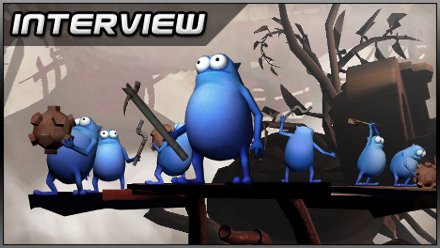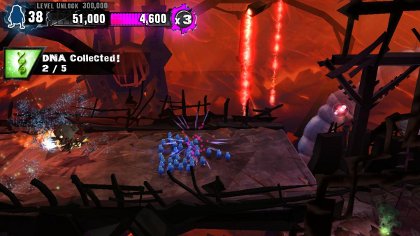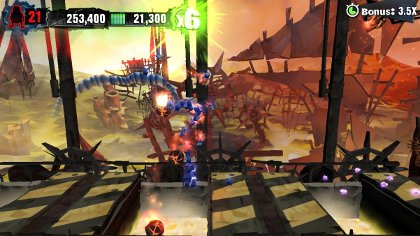
In some games, the idea is to destroy, in others, to preserve. Hothead’s downloadable oddity Swarm induces ferocious mental somersaults straight off the bat by asking that players both destroy and preserve, beginning each level with 50 chubby, docile blue Swarmites under their command and attempting to finish with just the one.
Controlled as a group, the Swarmites are the offspring of a rather larger and less personable alien lifeform known only as “Momma”. Traversing a hellish industrial landscape, the brood must reclaim blobs of DNA – or in other words, points – to spread their parent’s influence, unlocking new levels. You don’t just get points by collecting stuff, though – you can also haul ‘em in by casually murdering surplus Swarmites – tipping them off ledges into pools of lava, miring them in toxic gas or cramming them into air intakes, among other things.
It’s a strange, arresting proposition, presenting classic, pixel-precise platforming conumdrums in a whole new light, as you struggle to keep your army permanently on the brink of complete obliteration. The Swarmites run and jump like Mario and his ilk, but you can also cluster the group together by squeezing one trigger or spread them out by pulling on the other, depending on whether you want to minimise or maximise casualties.
Thirsty for more? Never fear – here’s Joel DeYoung, Hothead’s director of technology and Swarm producer.
You’re coming up to release on Swarm. Have you finished development?
That’s right, it’s done. We’re wrapped up pretty well. We’re just putting it into submission with Microsoft and Sony right now.
How do you feel about it?
Personally I’m really proud of Swarm – it’s been a long time coming, getting it done. We started the idea actually back in late 2006, pretty shortly after we started the company. The idea was put forward by Dr Mike Hayward, he’s our resident PhD here at Hothead. And his PhD research was in artificial life, artificial intelligence, based on the idea of having large groups of small autonomous agents cooperating to achieve a task.
So you can imagine maybe a bunch of small robots that are in themselves fairly simple but they work together to achieve something. And his idea was, what if you had these agents be little cute characters, and they were kind of dumb, but they could work together to save the day. And that’s kind of where things started.
We made a prototype, we entered the game into a contest that was being held here by Telefilm Canada, called the Great Canadian Videogame Competition – sort of an indie game dev contest. There were 70 entries and we ended up making it through the first few rounds into the final four. We got $300,000 out of that and a bunch of attention for the prototype, and we realised from the way people reacted to the demo and the characters that we’d created for it, we knew we had something on our hands.
So Mike sent the next several years just working on his own, honing the idea. The prototype was really cool, but what it involved was having a whole swarm of these little guys but taking control of one of them, and the rest would watch, and you’d do something and they’d try to imitate it, not always perfectly.
It was quite hilarious, and it was quite interesting as a mechanic, but we had this whole level where you were reclaiming an environmentally devastated landscape and destroying these mining machines, and the problem is the more you taught them to do stuff, and the more they remembered to do those things, the less you were actually doing things, and the more you were just watching the game unfold.
And we felt that that wasn’t really a game, so we played around with it, thought about how we could make it more “actiony”, something that’s more appropriate for the platforms we’re focussed on, like XBLA and PSN. So he came up with this idea of swarm control, taking control of the entire group of 50 swarmites all at once. And that’s where the action aspect of Swarm came from.
It looks very good. It’s nice to see Hothead itself getting a bit more limelight, too. With Deathspank, I think your role went unacknowledged at times simply because Ron Gilbert was involved.
Yeah, that’s true! Deathspank was definitely something that Ron Gilbert had created, it was his vision, his character, and that whole pitch. But then once we took it on and funded the game, worked on the game, it was definitely a collaborative team effort. But that’s fine, we were happy to work with Ron – he’s a giant in the business, and it was very cool to work on that game.
By contrast, this feels very much like your own project.
I hear what you’re saying. I think people that have played the Penny Arcade games and Deathspank will definitely recognise some similarities as well, because those games were made by the same group of people, and some of the similarities they’ll see will be quirky art direction, and a lot of strangeness.
The story in Swarm isn’t told very explicitly, and it’s pretty weird, and also just the humour. We don’t really take any of this stuff too seriously, and we end up putting a lot of funny stuff into the game. It’ll be a different kind of humour, not the dialogue-based humour we had in Deathspank. These guys die a lot, and it’s pretty hilarious. That’s something we found about Swarm, the game is just as much fun to watch as it is to play at times.







 Satoru Iwata Video Interview - the late Nintendo president spoke with Kikizo in 2004 as 'Nintendo Revolution' loomed.
Satoru Iwata Video Interview - the late Nintendo president spoke with Kikizo in 2004 as 'Nintendo Revolution' loomed. Kaz Hirai Video Interview - the first of Kikizo's interviews with the man who went on to become global head of Sony.
Kaz Hirai Video Interview - the first of Kikizo's interviews with the man who went on to become global head of Sony. Ed Fries Video Interview - one of Xbox's founders discusses an epic journey from Excel to Xbox.
Ed Fries Video Interview - one of Xbox's founders discusses an epic journey from Excel to Xbox. Yu Suzuki, the Kikizo Interview - we spend time with one of gaming's most revered creators.
Yu Suzuki, the Kikizo Interview - we spend time with one of gaming's most revered creators. Tetris - The Making of an Icon: Alexey Pajitnov and Henk Rogers reveal the fascinating story behind Tetris
Tetris - The Making of an Icon: Alexey Pajitnov and Henk Rogers reveal the fascinating story behind Tetris Rare founders, Chris and Tim Stamper - their only interview? Genuinely 'rare' sit down with founders of the legendary studio.
Rare founders, Chris and Tim Stamper - their only interview? Genuinely 'rare' sit down with founders of the legendary studio. The History of First-Person Shooters - a retrospective, from Maze War to Modern Warfare
The History of First-Person Shooters - a retrospective, from Maze War to Modern Warfare